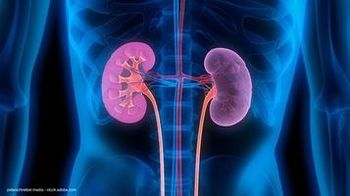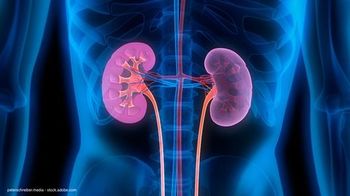
Fluorescein study refutes permeability theory of IC
Atlanta-Although the etiology of interstitial cystitis is unknown, one of the most popular theories is that patients have especially permeable bladders that allow noxious substances through, eliciting pain and other symptoms. But a study of bladder permeability in IC patients presented at the AUA annual meeting here cast doubt on what has become almost common wisdom.
Atlanta-Although the etiology of interstitial cystitis is unknown, one of the most popular theories is that patients have especially permeable bladders that allow noxious substances through, eliciting pain and other symptoms. But a study of bladder permeability in IC patients presented at the AUA annual meeting here cast doubt on what has become almost common wisdom.
The study of uptake of fluorescein instilled into the bladders of IC patients actually showed less, not more, uptake into the bloodstream, based on body mass, than the authors had expected.
"Our very early pilot data, when we put the fluorescein in the bladders of very early IC patients before their bladders were distended under anesthesia, suggested that we would probably confirm what everybody thinks is true, which is more uptake in IC patients than in controls," Robert Mayer, MD, associate professor of urology, University of Rochester (NY) Medical Center, told Urology Times.
In addition, it is not very specific for IC. Several other intravesically administered agents have been tried in assessing bladder permeability, including 99m technetiumdiethylenetriaminepentaacetic acid, ethanol, and buffered lidocaine, but they, too, have not shown adequate specificity to distinguish between IC patients and controls. Fluorescein uptake, however, was thought to have potential as a measure of bladder permeability that would differentiate between IC and control patients.
Unlike patients in the encouraging pilot study of fluorescein uptake, the 12 women with IC in this study had symptoms and had been treated for an average of 5 years. Their scores averaged 10.2 on the O'Leary-Sant IC Symptom Index and 8.5 on the O'Leary-Sant IC Problem Index, compared with 2.1 and 0, respectively, for the 11 control women. Daily frequency in the IC women averaged 13.5 voids compared with 6.5 voids for the control women.
Investigators instilled fluorescein, the intensely fluorescing orange-red dye that is the workhorse of ocular angiography, into the awake subjects' bladders and then intensively sampled plasma every 1 to 2 minutes over a 30-minute period to look for fluorescein. At first, the researchers used 50 mL of fluorescein, 10 mg/mL, but increased that to 100 mL because initial values were just above detectable levels.
Uptake reached a peak at about 20 minutes, despite the continued presence of dye in the bladder; and the increased volume of instilled dye did not significantly increase maximum values. The uptake, calculated at 20 minutes and corrected for body mass index, showed that control patients had significantly greater uptake than did IC patients (p<.05).
Because the number of study subjects was small, it isn't 100% certain that IC patients have less uptake; however, results imply that 5 years of treatment have possibly changed the bladder barrier. The other possibility, Dr. Mayer said, is that IC patients may have an abnormal bladder lining that allows detection of increased fluorescein uptake while under anesthesia, but local blood flow to the bladder may be relatively reduced in awake patients and may result in impaired systemic uptake of the dye.
"So there's other work to be done-looking at younger patients, looking at them awake and under anesthesia. But right now, this is not ready as an outpatient test," he concluded.
Newsletter
Stay current with the latest urology news and practice-changing insights — sign up now for the essential updates every urologist needs.

















